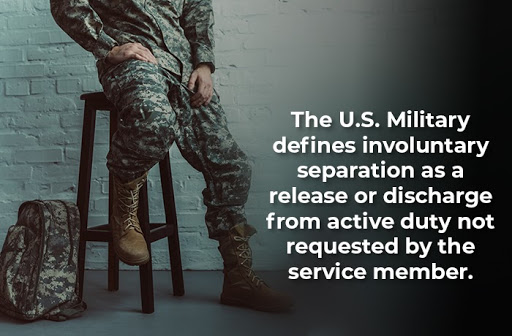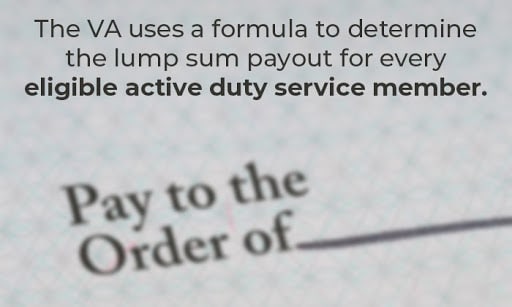If you were recently separated from the US military without your consent, you undoubtedly have a lot of questions. While millions of Americans lose their jobs every year and receive severance pay, this is tremendously different from involuntary separation pay from the military.
Non-Disabled Military Separation Pay Eligibility Criteria
Involuntary separation is when someone is released or discharged from active duty military service without requesting it. If you are denied reenlistment or have requested an extension of active duty, you will not get military separation pay.
Is Involuntary Separation Honorable?
Military separation pay is only available to veterans who were honorably discharged or given a General under honorable conditions discharge. If you receive an other-than-honorable discharge, you are not eligible for involuntary separation pay.
What is the Amount of Separation Pay?
There are two types of military separation pay- full and half. Full pay is based on the number of years you have served, while half pay is based on other factors. In order to be eligible for either type of payment, you must have served in the military for a minimum of 6 years but no more than 20 years.

Military Full Separation Pay
Active duty military personnel who are being involuntarily separated must satisfy these standards to be eligible for complete separation pay:
- Military service noted as honorable
- Qualified for retention at the time of separation
- Agree to serve in the Ready Reserve or a similar unit for up to three years after leaving active duty military service
Some examples of involuntary discharge considered honorable include exceeding your rank’s high tenure and a military reduction in force measure.
What counts as involuntary separation?
There are a few different types of involuntary separations, but the most common one is known as a “non-selection”. This happens when the military decides not to retain an individual even though they meet all the required qualifications for service. Other involuntary separation reasons can include the inability to pass basic training, serious medical conditions, misconduct, and court-martial convictions.
Do you have to pay back military separation pay?
It depends. Normally, you do not have to pay back involuntary separation pay. This is a benefit that is meant to help you during this difficult time. However, if you receive any other type of military benefits or VA benefits (like service-connected disability payments), those may be subject to repayments.
Military Half Separation Pay
Half separation pay is available to those who have met the same requirements as full separation pay. The standards for discharge are less strict and can be given for honorable or general reasons. Some of the most common reasons people receive half separation pay are involuntary separations like:
- Inability to meet weight and fitness standards
- Losing security clearance
- Involuntary discharge for family or personal reasons
- Members of the Reserve who volunteered for an additional tour of active military service but did not receive approval
- Disability present prior to enrollment in military service that prevents further active duty
- Physical or mental health conditions not considered a disability
- Failure to complete drug or alcohol rehabilitation successfully
- Inability to meet the minimum retention standards as part of a service obligation
Military separation pay is a one-time lump sum payment determined by your rank and grade. For 2020, the lowest payment is $16,580 for an E-3 Grade 6 rank, while the highest payment is $132,257 for an E-9 Grade 18 rank.
If you have at least 15 to 20 years of service in the military, you may be able to get the Temporary Early Retirement Authority (TERA) program. You have to ask your branch of service for TERA benefits, which they will then look at on a case-by-case basis. This program offers ongoing payments that can be significantly more than the one-time payment available under military separation pay rules.

Military Members Not Eligible for Separation Pay
Even if you meet the years of service requirement, you would not be eligible for military separation pay if any of the following apply to you:
- Voluntary separation of service request
- Release from active duty to military training
- Service member eligible for retainer or retirement pay as described above
- Chief Warrant Officer with a terminated appointment during the three-year probationary period and who chooses military reenlistment
- Chief Warrant Officer who does not receive two consecutive promotions to the next applicable grade currently serving active duty at a grade of CWO-4 and who opts to retain their active duty status in their current rank.
- Permanent or temporary officers performing limited duty at O-4 level or higher while complying with an active-duty career objective.
- O-3 or O-4 active-duty officers who fail to achieve promotion to the next highest grade two consecutive times and who plan to retire within two years of eligibility for retirement.
- Service members released due to a court-martial sentence, discharge, or dismissal
- Service members who separated without honorable conditions
- Enlisted service members ininvoluntarilyeparated due to unsatisfactory job performance or misconduct
- Involuntary separation of service members completing an obligated service period
How to Calculate Involuntary Separation Pay
The Department of Veterans Affairs (VA) calculates each active-duty military service member’s lump-sum payment based on a formula. If you didn’t serve a full year, each month of service is equal to 1/12 of a year.
To determine your payout, take 10 percent, multiply it by years of active duty service, multiply that by 12, and multiply that by the monthly basic pay you received most recently.

Special Considerations Regarding Military Separation Pay
It’s critical to understand the whole rules and responsibilities you’re agreeing to when you join up if you’re considering military separation pay. Some key phrases to remember include:
- If you are qualified for retainer or retirement pay later under Title 10 or Title 14 of the United States constitution, the military may ask you to pay a monthly retainer to recover its costs.
- If you were eligible for both disability compensation and military separation pay and received them, you must reimburse the Department of Veterans Affairs for the full amount you received in separation pay. The VA does not take away your disability payment based on any prior military service.
- The Internal Revenue Service (IRS) will charge you a 20% to 25% tax on your military separation pay. There is currently no option to modify your deduction percentage, but you may get a refund if you overpaid taxes this year.
- After receiving military separation pay, you may join the National Guard or Reserves. If you leave the National Guard or Reserves, however, you will have to return your separation pay. Until you repay the full amount of your lump-sum payment, the Department of Defense Finance and Accounting Service (DFAS) deducts 40% of your retirement payout.
- You have the option of requesting that DFAS withhold a higher amount from each payment to meet your obligation faster. The organization does not currently allow reserve and retired National Guard and Reserves service members to make lump-sum payments.
- If you receive disability compensation related to military service, the VA must withhold some of your pay in order to cover the taxes you have already paid. This rule applies to both voluntary and involuntary separation pay.
The military may also pay a family separation allowance, which is a different kind of compensation. When your dependent relatives can’t live with you or near you while they’re on active duty, the DFAS allows you to receive up to $250 per month. This also applies if your family members must be evacuated and relocated to a safe location until the danger is minimized.




